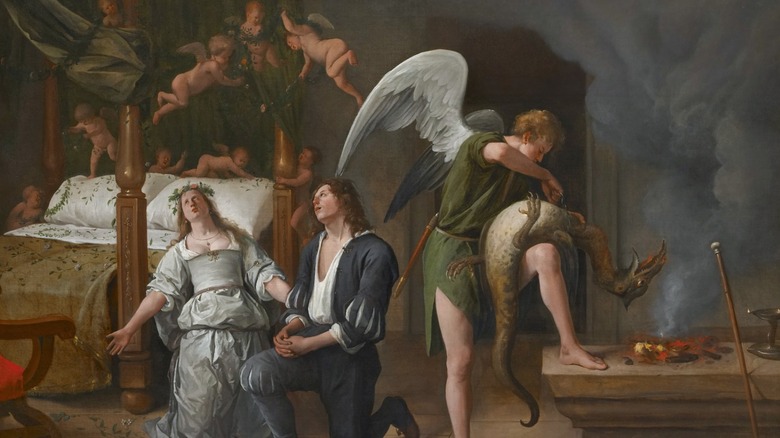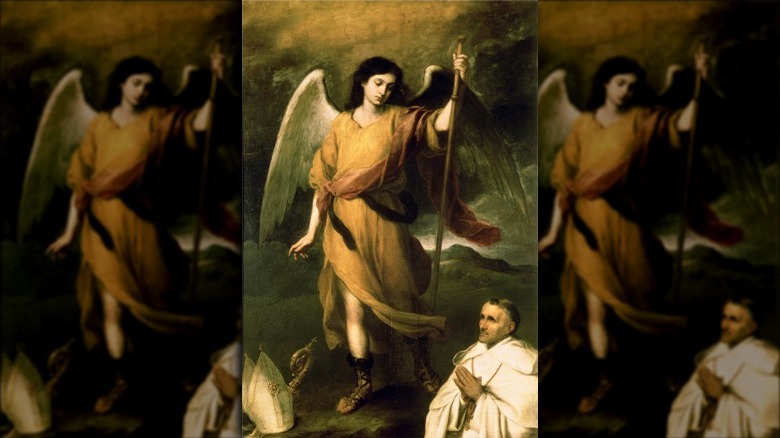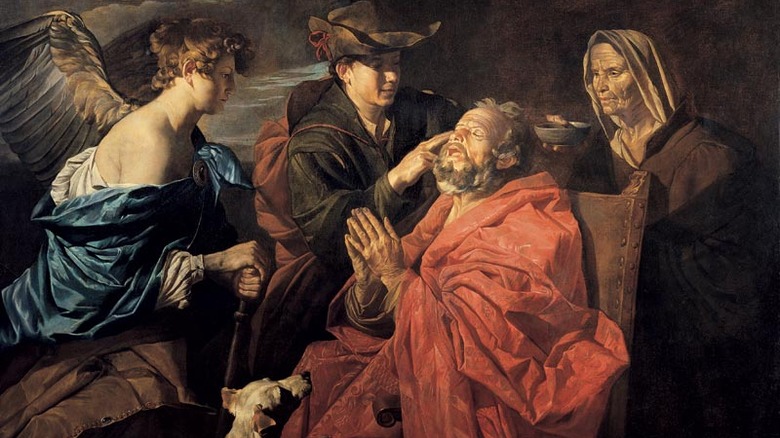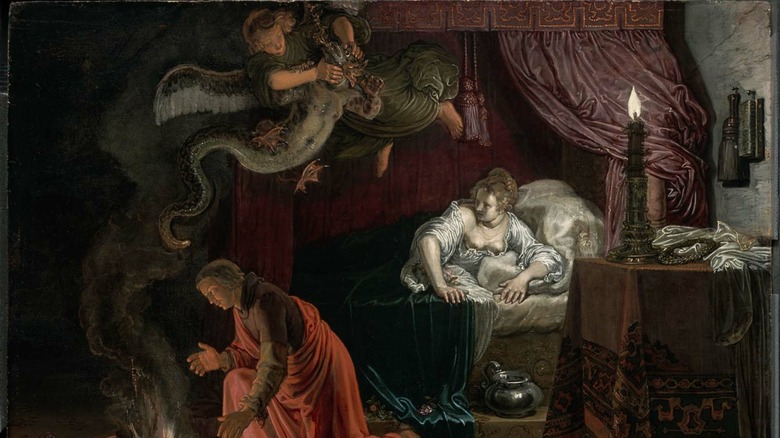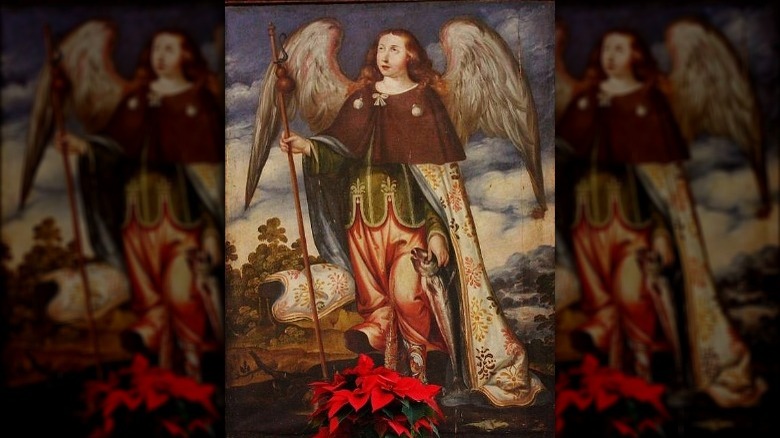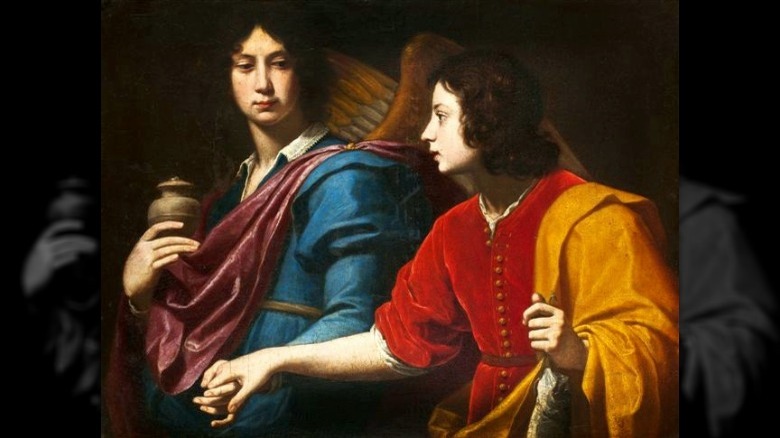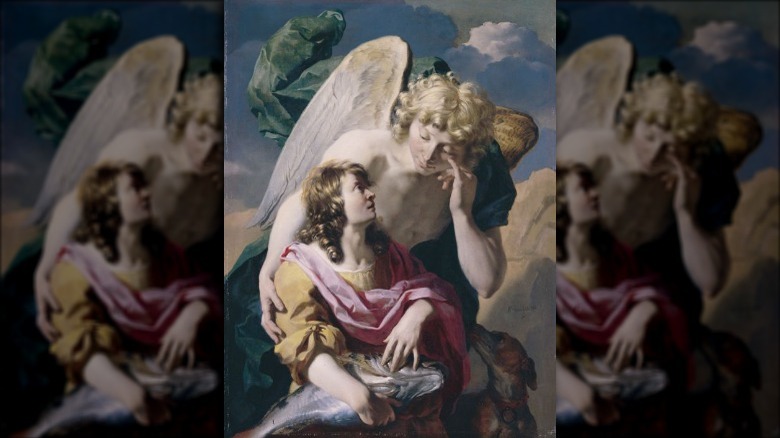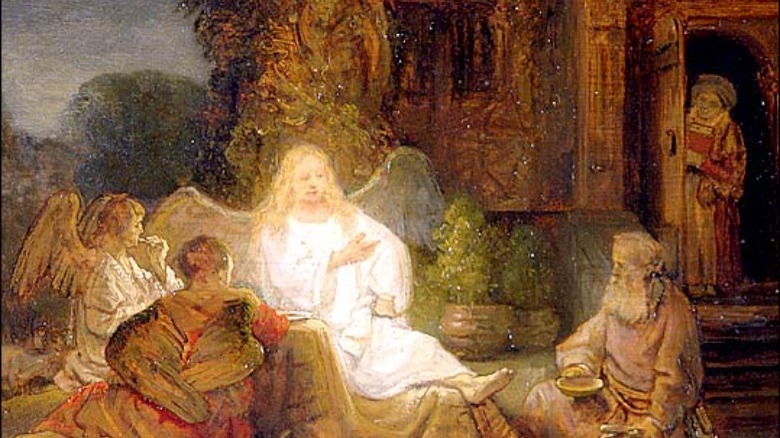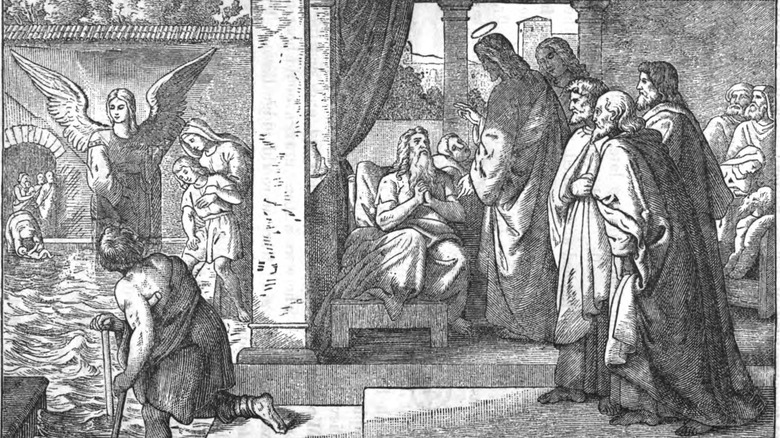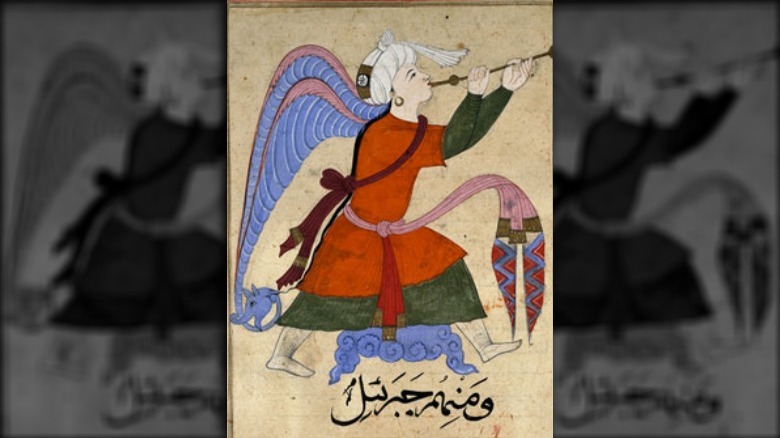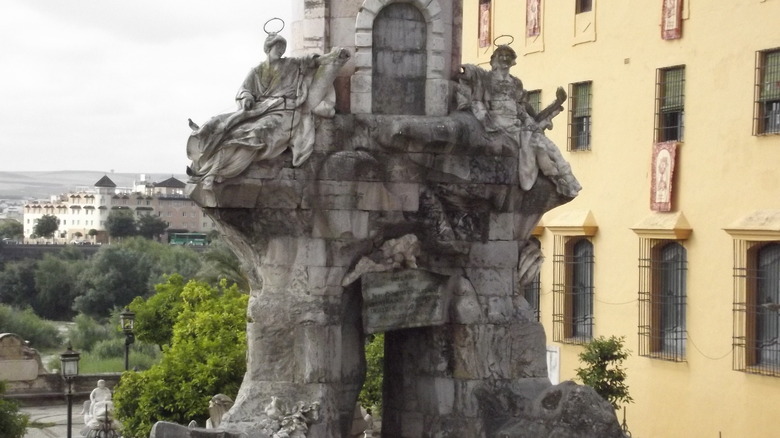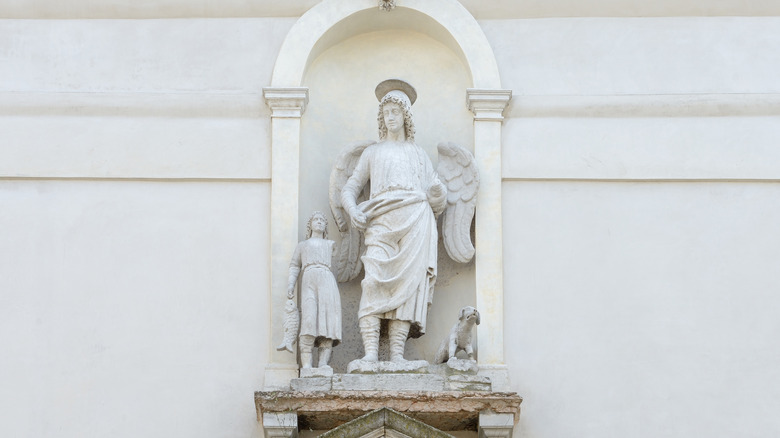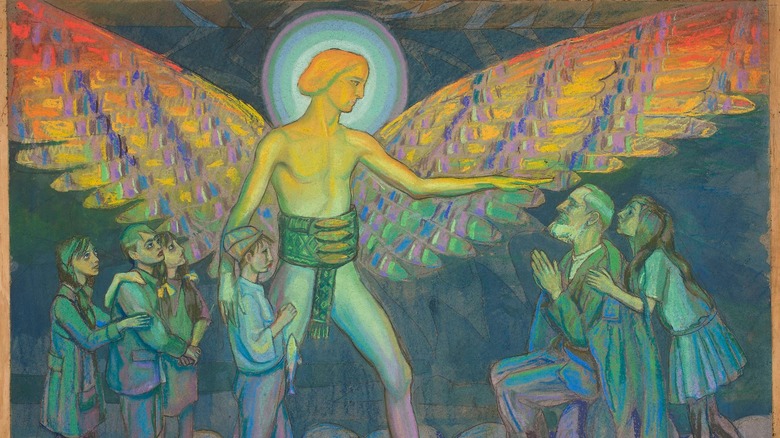The Archangel Raphael: The Untold Truth
The most famous angels are Michael and Gabriel, but they are far from the only ones to be found in the body of Jewish, Christian, and Islamic texts and traditions. After those two, the most prominent angel of them all is Raphael, the archangel of medicine and travelers. Unlike Michael and Gabriel, however, Raphael gets more than just a cameo in the Bible; he's a major character for basically an entire book of the Bible.
If you've never heard of Raphael, or if that name is just a Ninja Turtle to you, there's a lot to learn about this healer of blindness, binder of demons, guardian of sailors, patron of matchmakers, and smoker of fish. Raphael is not, it turns out, cool but rude, but rather cool and kind (except potentially to pilgrims at the pool of Bethesda). Read on to find out what the third most famous angel of them all has to offer.
Raphael: God's healer
As the Jewish Encyclopedia explains, the name Raphael doesn't appear in the canonical Hebrew Bible. In fact, the only angels given proper names at all are Michael and Gabriel, who are both mentioned in the Book of Daniel, one of the last books in the Hebrew Bible to be composed. The omission of the angel Raphael is likely not intentional, as Raphael is a key figure in apocryphal literature from the same era. Whenever more than two angels are mentioned, Raphael is almost invariably the third. Together with the archangel Uriel, these four angels are said to be the ones that stand positioned around the throne of God, each in one cardinal direction. Rabbinical literature suggests that Raphael stands to God's west.
Like most angels, his name ends in -el, the Hebrew word for God. Raphael, according to the Catholic Encyclopedia, means "God has healed," and between the name and his function as a healer knowledgeable of cures and ointments in the Book of Tobit, Raphael has subsequently become associated with medicine and healing. The angel's name is of course the source of the name of the Renaissance painter, and consequently the Ninja Turtle of the same name. Ironically, however, because of his association with medicine and his depiction in art carrying a staff, Raphael is actually more like the turtle Donatello of the archangels. (Sinner-punishing Uriel is the turtle Raphael.)
Raphael makes the scene
While the archangels Michael and Gabriel are well known because of their roles defeating Satan's armies and announcing the birth of Christ, respectively, these events are still ultimately little more than cameos in the greater narrative. Raphael manages to be a main character in an entire Bible book from basically start to finish. The book in question is the Book of Tobit, which is not included in most Protestant Bibles, but which is canon for the Catholic and Orthodox Churches. The inciting incident is that the titular Tobit, a faithful and courageous Jew in exile in Assyria, is blinded when a bird poops in his eyes. Tobit's son, Tobias, is assigned the job of traveling to a relative's house to recover some money that Tobit had left in his care.
Fortunately, Tobias doesn't have to travel alone. He gets help in the form of the archangel Raphael, who disguises himself as one of Tobit's relatives, Azariah son of Hananiah, so that Tobit will entrust his son to his care on his long journey. Handily, Raphael, as the angel of healing, also knows how to cure Tobit's blindness: with the gall from a certain fish that he helps Tobias to catch in the Tigris River. This fish will come in handy in other ways, too, because the Book of Tobit is about not just one, but two families.
Playing Tobias' (literal) wingman
Besides Tobit, his wife Anna, their son Tobias, and Tobias' dog (notably the only positive mention of dogs in the Bible), the Book of Tobit also focuses on Tobias' cousin Sarah, who lives in Ecbatana, a city on the path of Tobias' journey. Sarah, it turns out, has been married seven times, but each marriage has lasted less than a day, as her husbands all die on their wedding night. Perhaps naturally, Sarah has been accused of being responsible for their deaths, but savvy readers will guess that she is actually innocent. The figure actually responsible for all these deaths is Asmodeus, the demon of lust. By coincidence, Sarah's prayer is heard at the exact same moment as Tobit's by the archangel Raphael. As such, Raphael's plan to help Tobias is secretly also a plan to help Sarah.
When Tobias and Raphael catch the fish from the Tigris, Raphael tells Tobias that the gall of this fish will cure his father's blindness, but by burning the fish's heart and liver, he can repel demons. Tobias doesn't realize the significance of this until they stop in Ecbatana, where Tobias meets his cousin Sarah for the first time and learns of her plight. Tobias and Sarah are married, and as expected, Asmodeus shows up on the wedding night. He is repelled by the fish vape and bound in the desert by Raphael.
The roles and symbols of Raphael
Within the denominations of Christianity that venerate saints, these saints often gain patronages (the people they protect and the things they protect against) due to miracles they performed, details of their death, and sometimes just associations people make with their story. Angels are no exception. Due to his name and his ability to turn fish guts into blindness-curing medicine in the Book of Tobit, Raphael has gained a reputation as the patron of physicians, nurses, pharmacists, medical workers, and any kind of healer.
According to Catholic Online, however, he is also the patron of travelers and pilgrims (because he accompanied and protected Tobias on his journey), happy meetings (because he made it seem like he just randomly bumped into Tobias when he needed him), the blind (because he healed Tobit's blindness), lovers (because he helped Tobias and Sarah get married), young people (like Tobias), and people suffering from nightmares (because he saved Sarah from the demon who haunted her at night).
These elements also inform the way that he is depicted in art. If you can't tell which angel is which when you're visiting a church, look at what they have with them or around them. Raphael is often depicted carrying a staff (associated with travelers and pilgrims), holding or standing on a fish (like the one he used to heal Tobit and defeat Asmodeus), and is sometimes accompanied by Tobias and his dog.
Raphael busts a different demon
The Book of Enoch – which is apocryphal for most Jewish and Christian denominations, but canonical for the Ethiopian Orthodox and Beta Israel denominations, and also quoted in the New Testament Epistle of Jude — has a lot to say about angels, both good and bad. The early portions of the book are focused on fallen angels that fell in lust with human women, filled the world with their cannibal giant spawn, and taught humanity numerous dark arts such as black magic and cosmetics. But the book talks about good angels, too, and shows them doing their various roles as the titular righteous man Enoch is given a tour of heaven.
When God seeks to punish the fallen angels for their crimes, he summons his faithful archangels to carry out the sentence. In Chapter 10, God sends Uriel to warn Noah of the impending flood that will clear the Earth of the giants, and sends Raphael to capture the demon Azazel, one of the ringleaders of the fallen angels. Just as he did to Asmodeus in the Book of Tobit, Raphael binds Azazel by the hands and feet and drags him to the desert. The desert in question here is called Dudael, and in it Raphael digs a deep hole, throws Azazel in, and buries him in jagged rocks, where he will remain until Judgment Day, when he'll be cast into hell.
Asmodeus, again
Raphael is mentioned again as the foiler of Asmodeus, demon of lust, in the medieval demonological text known as the Testament of Solomon. This text is based on the popular legend that King Solomon constructed the first temple in Jerusalem by using a magic ring that allowed him to command and control demons. One of the demons he summons is Asmodeus, who expands on his role as a demon, saying that his MO is to cause men to desire other men's wives, leading ultimately to adultery and jealous murder, as well as causing tragic deaths among the newly wedded, such as he did in Tobit.
When Solomon asks which angel has power over him, Asmodeus of course replies "Raphael," but he gives the details that the fish that ruined him was a large catfish called Glanos, which lives in the rivers of Assyria, and the wood over which it was smoked was tamarisk. Later in the text, Solomon summons a she-demon called Obizuth, with a body made of darkness and wild hair like a dragon's (you know, dragon's hair), who goes around by night and strangles newborn babies. She can be driven away, however, if someone writes the name of the angel Raphael (or his secret name, Afarot, or the numerological equivalent of his name, which is 640) on the body of the woman in labor.
Raphael heals Abraham's downstairs situation
In Chapter 18 of the Book of Genesis, the great Jewish patriarch Abraham is sitting by his tent in an oak grove when he suddenly sees three men. He greets these men warmly, washing their feet and offering them a place to rest and something to eat. As it turns out, these three men are actually God and two angels coming to visit. In return for Abraham's hospitality, God prophesies that the long-childless Abraham will have a son in the next year, and he warns him about the impending destruction of Sodom and Gomorrah.
While the text of Genesis identifies the chief of these three figures as the Lord himself, Ask the Rabbi explains that the Talmud identifies the three figures as the angels Michael, Gabriel, and Raphael. Michael is the chief among them, and is the one who talks to Abraham. Each angel had a job: Michael's job was to tell Abraham and his wife about the forthcoming birth of their child, Gabriel's job was to destroy Sodom and Gomorrah, and Raphael was sent to warn Abraham's nephew Lot about the impending destruction. In fact, according to one tradition recorded in Legends of the Jews, Rapahel also had a second task befitting his role as a healer: his job was to heal Abraham's circumcision, which he had just had done in the previous chapter of Genesis to seal his covenant with God.
Raphael's angel jacuzzi
Although the archangel Raphael does not appear by name in any book of the New Testament, some Christians believe that he is still there. In Chapter 5 of the Gospel of John, Jesus goes to visit Jerusalem for a religious festival, and while he's there, he goes to a pool called Bethesda, where a large number of sick and disabled people hang out hoping to be healed. They aren't hoping completely in vain: it was believed that from time to time an angel would visit this pool and stir up the water, and the first person to enter the water after the sign of the angel's presence would be healed.
In the Gospel account, Jesus encounters a man who has been there for 38 years because he was too sick to get to the water under his own power and someone always beat him there. Perhaps needless to say, Jesus heals him and then gets yelled at for doing miracles on the Sabbath. If you haven't read the Gospels, there's a lot of that.
As the Catholic Encyclopedia explains, a number of commentators have identified the angel at Bethesda as not just some rank and file flyboy, but indeed, the archangel Raphael, spirit of healing. Why this angel didn't just heal anyone who asked for it instead of making it a weird race is not explained.
Raphael's Muslim equivalent, Israfil
Some of the angels from the Jewish and Christian traditions are also found in Islamic literature. Michael and Gabriel, for example, are found in Arabic holy texts as Mika'il and Jibril. Raphael, meanwhile, is generally thought to be reflected in Islam by the angel Israfil, though the Encyclopedia Britannica points out that Israfil could also possibly be analogous to the angels Uriel or Seraphiel. While Israfil is not explicitly mentioned in the Quran, he does appear in a number of other key traditional works. In this literature, Israfil is described as so tall that his body — which is covered in hair, mouths, and tongues — reaches from the Earth to the highest Heaven. He has four wings, one which he uses to protect his own body, one with which he shields God, and one each to stretch to the east and west. Every day he cries three times from seeing people suffering in hell. Tradition also says he trained Muhammad for three years in how to be a prophet.
Israfil's main role, however, is to be the angel who will blow the trumpet to mark the Day of Resurrection, a role that in Christian tradition is frequently assigned to Gabriel. It is said that the trumpet is constantly on his lips at the ready for the instant that God orders him to sound the coming resurrection from the Dome of the Rock in Jerusalem.
Raphael loves Spain
One city where the cult of the archangel Raphael is particularly strong is Cordova, Spain, where Raphael is thought to have appeared a number of times in the 13th and 16th centuries. ArtenCordoba explains that the earliest apparitions of Raphael here began during the plague of 1274. During this epidemic, Bishop Pascual instituted a hospital and cemetery for those struck by the plague in the area that is now known as Triunfo Square. It was at this time that the angel appeared to a monk named Simon de Sousa, telling him that God was very pleased with the bishop's care of his parishioners and that he would show pity on the people of Cordoba. In exchange, they should build an effigy of the archangel to put on top of a local church. When the plague returned to Cordova in the 18th century, monuments dedicated to the angel known as the Triumph of San Rafael were built all around the city to invoke his protection.
The better known apparitions of Raphael appeared in the 16th century, when the angel appeared to Father Andres de Roelas numerous times. During the final time, the angel swore a solemn oath that he was indeed the archangel Raphael, whom God had appointed as the city's guardian. A church dedicated to Raphael's oath was built in Cordova in the late 1700s.
Raphael loves Venice too
Another city where the archangel Raphael is particularly venerated is Venice, Italy. Part of the reason for this is the association between Raphael and protection for sailors. As the Queen of Angels Foundation explains, Raphael's reputation as a binder of devils made him an ideal guardian for sailors. Nowhere is this more evident than in a statue of Raphael on the corner of the Doge's palace in Venice, in which the angel is positioned facing the sea and holding a scroll on which is inscribed the rhyming Latin line, "Effice, quaeso, fretum, Rafael reverende, quietum" ("Please, honorable Raphael, keep the gulf [of Venice] quiet").
One of the oldest churches in Venice is dedicated to Raphael. According to Churches of Venice, the Church of Angelo Raffaele was built in either 416 or 650, depending on which legend of its founding you believe. One says it was built in response to a vow by a noblewoman to build a church if her husband returned safely from battling Attila the Hun. The other says the church was the second of eight churches in Venice built by Saint Magnus of Oderzo. Whenever it was built, it was demolished following fire damage and rebuilt in the 17th century. This version can still be seen today, complete with a statue of Raphael, Tobias, Tobias' dog, and the fish.
When to celebrate Raphael
If you're particularly into the idea of venerating Raphael, the archangel in protection of doctors, travelers, and young people in love, you have a couple of choices for the ideal day on which to do it. According to the Catholic Encyclopedia, the official feast day for Saint Raphael was originally October 24, on which hymns are sung praising his abilities in healing and demon-stomping and the story of the healing pool of Bethesda is read. However, as the Queen of Angels Foundation explains, since 1969 his celebration has widely been lumped together with the archangels Michael and Gabriel on September 29, but some churches still celebrate Raphael on October 24.
Some places have localized celebrations of Raphael, though. Cordova, Spain, celebrates Raphael on May 7, the date of the most famous apparition of the angel there. Bordeaux, France, had two different feast days for Raphael in the 15th century: July 8 and October 13. As the New Liturgical Movement records, within Orthodox Churches, Raphael is celebrated with the other archangels on November 8, as part of the "The Synaxis of the Great Commanders Michael and Gabriel, and the rest of the Bodiless Powers," but sadly Raphael is not mentioned by name in that day's liturgy. Whichever day you choose to commemorate the angel of healing, maybe celebrate it by petting a dog and eating a smoked fish.
